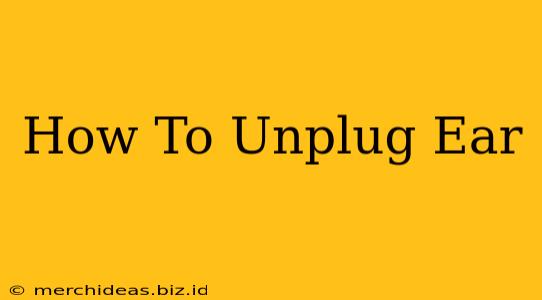Dealing with a plugged ear can be incredibly frustrating, making it hard to hear and sometimes causing discomfort. Fortunately, most plugged ears are easily treated at home. This guide provides safe and effective methods to unplug your ear, along with when you should seek professional medical attention.
Understanding Why Your Ear Might Feel Plugged
Before we dive into solutions, let's explore the common causes of a plugged ear feeling:
- Earwax Buildup: This is the most frequent culprit. Earwax, or cerumen, naturally protects your ear canal, but excessive buildup can block sound and cause a fullness sensation.
- Fluid Buildup (Serous Otitis Media): Sometimes, fluid can accumulate in the middle ear, particularly after a cold or other upper respiratory infection. This can lead to a muffled feeling and pressure.
- Eustachian Tube Dysfunction: The Eustachian tube connects your middle ear to the back of your throat. If this tube becomes blocked, it can prevent proper pressure equalization, leading to a plugged feeling. Changes in altitude (flying, driving up mountains) can exacerbate this.
- Foreign Object: A small object, like an insect or piece of cotton, may have become lodged in your ear canal.
- Infection: An ear infection (otitis media or otitis externa) can cause pain, pressure, and a feeling of fullness.
- Barotrauma: Changes in air pressure (like during flying or scuba diving) can cause significant discomfort and a feeling of pressure or blockage in the ear.
Safe Home Remedies to Unplug Your Ear
Several at-home techniques can help alleviate a plugged ear sensation. Always use gentle pressure and stop if you experience any pain.
1. Gravity Assist:
- The Technique: Lie on your side with the affected ear facing upward. Hold this position for several minutes, allowing gravity to help dislodge the wax or fluid. You can repeat this on the other side.
2. Warm Compress:
- The Technique: Apply a warm, damp washcloth to the affected ear for 10-15 minutes. The warmth can help soften earwax and potentially relieve pressure.
3. Ear Candling (Use with Caution):**
- The Technique: While some people use ear candling, this method is generally not recommended by medical professionals due to the risk of burns, infection, and ineffective wax removal. It's far safer to use other methods.
4. Saline Solution:
- The Technique: You can purchase over-the-counter ear drops containing saline solution. Follow the package instructions carefully. These drops help soften earwax.
5. Over-the-counter Earwax Removal Drops:**
- The Technique: Many pharmacies sell earwax removal drops designed to soften and loosen earwax. Again, adhere to the instructions on the packaging.
When to See a Doctor
While many plugged ear issues resolve on their own or with home remedies, you should see a doctor if:
- You experience severe pain.
- You have a fever.
- Your symptoms worsen or persist for more than a few days.
- You have drainage from your ear.
- You suspect a foreign object is lodged in your ear.
- You have hearing loss.
Your doctor may use specialized instruments to safely remove earwax or diagnose any underlying medical conditions. Never attempt to remove earwax using cotton swabs or other sharp objects, as this can push the wax further in and cause damage.
Preventing Plugged Ears
To minimize the risk of plugged ears:
- Avoid using cotton swabs.
- Keep your ears clean but avoid aggressive cleaning.
- Consult your doctor about earwax buildup if you experience frequent issues.
By understanding the causes and employing these safe and effective methods, you can successfully address a plugged ear and regain clear hearing. Remember to consult a doctor when necessary for appropriate diagnosis and treatment.
